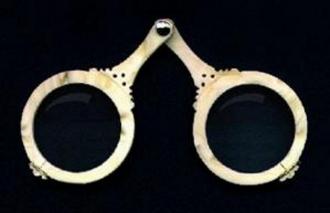 Adi Sankaracharya (509 – 477 BCE) has used ‘Upanetra‘, which were eyeglasses used to achieve magnification effect.
Adi Sankaracharya (509 – 477 BCE) has used ‘Upanetra‘, which were eyeglasses used to achieve magnification effect.
In his work ‘Aparokshanubhuti‘ (Direct Experience), 81st verse, Sankara states : ‘Just as all objects that are very small appear to be large when viewed through lenses, so does one, etc’.
This book expounds Advaita Vedanta philosophy.
He describes a method that seekers can follow to directly experience the essential truth of one’s one nature.
This means that either lenses or magnifying glasses were used in India to magnify objects or letters.
The context of upanetra in the above text makes it clear that some sort of magnifying lens or spectacles were used (upa(sub)-netra(eye) suggests that some lens were used to help eyes view better and bigger.
Before this book, no available literature so far has mentioned about any such lenses.
So, it can be concluded that ancient Indians used spectacles or magnifying lenses to view objects better atleast 2500 years ago.
Origin of Spectacles in India
Agents of the British East India Company have been incorrectly credited by some writers with introducing spectacles into India.
There is a reference (in a letter dated 22 September, 1616 CE, from an English firm “Kerridge, Barker, and Mittford“) to the slow sale of English spectacles in Rajputana, the modern state of Rajsthan in North India.
There are references to spectacles in the Hindu literature much earlier than this, and spectacles are also depicted in some of the Mughal miniatures.
The ancient Indian spectacles generally had carvings of a deity, and perhaps Indians at that period did not want to use non-Indian spectacles, which may account for the slow sale of the English importations.
The account of Devanarayan (between 1344-1353 CE), the use of spectacles by Vyasaraya (1520 CE), the indigenous manufacture of spectacle lenses in South India, the different terms used for spectacles in the North and South Indian languages, and other historical facts all indicate that spectacles were invented in India, in all probability by the Kannada-speaking Hindus.
It is therefore most likely that the use of lenses reached Europe via the Arabs, as did Hindu mathemetics and opthalmological works of the ancient Indian surgeon Susrutha, who performed first Cataract surgery.
Spectacles called Upalocanagolaka (spectacles-rounded) or Upanetra in Sanskrit were used not only among the upper classes but also by the middle classes.
One reference to the spectacles is to be found in a Gujarati poem “Casimasabda-Satarthi-Svadh-yaya” composed by Somavimalasuri, a Jain poet of Ahemdabad in about 1576 CE.
The word used here is chasima or chasma which is equivalent to Persian word chashm meaning an eye.
Pinhole Glasses, for improving vision – How they work

The concept of Pinhole Glasses was used in India thousands of years ago.
Each pinhole permits only a narrow beam of light to reach the eye. The light passes only through the centre of the lens of the eye.
So any defects of the eye lens will not take effect while the light is targeted in that way.
Peripheral vision will also be reduced.
Ancient Indians used to cut diamonds into small pieces without using any visual aids. India was the only source of diamonds in the world, until they were discovered in South Africa in 1886 CE.
Takshasila University taught students from neighbouring countries like Russia, China, Greece, Thailand etc how to make glass, as mentioned in a Vedic book Satapatha Brahmana.
History of Lenses across the Globe
Chinese used glasses and lenses ever since they learned it at Taxila or Takshasila.
In 20 CE, a Roman named Seneca looked through a globe of water in order to help him magnify the print in the ancient Roman Books.
In 60 CE, Roman Emperor Nero wore eyeglasses with LENSES made of EMERALDS to view the gladiator games.
In China (around 1430 CE )judges used to darken their glasses for the purpose of concealing their eye expressions in court. (This could be the origin of Sunglasses).
Although Nimrud Lens is found to be the first glass for magnifying objects (it was used as telescopic lens), there are many further developments in lenses and spectacles.
Spectacles were mentioned in the medical books in Europe in the beginning of the 14th century.
Rollover mouse on below images to read their details
 |  |
 |  |
 |  |
Spectacles spread amongst the Muslims after the 13th century. It started to be mentioned in the literature, poems, paintings and history books. In one of the poems of Ahmad al-Attar al-Masri a section may suggest that he was mentioning the spectacles when he says: “the old age came to me after youth, I had a strong vision and now my eyes are made of glasses”:
رمى بعــد اعتدالي باعـوجاج أتى بعد الصبا شيبي ودهري
وقد صارت عـيوني من زجاج كفى أن كان لي بصر حـديد
In another occasion, the historian al-Sakhāwī said about the calligrapher Sharaf Ibn Amīr al-Mārdīnī (died in 1447): “he died with an age that exceeded 100 years; he had good senses and he continued writing even without using a mirror.” A mirror here means lenses.
